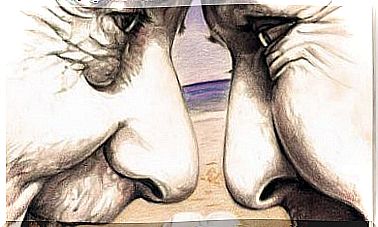The 4 Types Of Internal Dialogue To Avoid

Everyone, at some point in our lives, goes through painful moments or unexpected negative situations that we must overcome . However, these types of experiences mark some people in such a way that they develop a negative internal dialogue.
This dialogue is not in itself recommended, but it is even more dangerous when it threatens to linger and become a habit. The truth is that nobody is exempt from being faced with a problem that they are unable to solve.
This inability to solve the problem may be due to its complexity or that we do not have enough tools to solve it. Under these circumstances, and if we value the problem as important, it is normal for anxiety to appear : the challenge has become a threat.
Anticipatory anxiety
In this type of disorder it is usual to have internal dialogues that reinforce negative ideas and that return us to the painful episode that we have not yet overcome. The worst thing is that when faced with each new experience that reminds us of what happened, we begin to react negatively, considering it potentially dangerous.
Anticipatory anxiety is the main component of these types of thought dynamics when they have established themselves in us. From here, the person develops distorted statements that are constantly repeated and the initial anguish increases, until it becomes intolerable.
When people suffer from states of anguish and anxiety, they tend to develop an internal dialogue of a catastrophic nature. Of course, this vision of life is the product of an altered and, therefore, distorted emotional state. The danger of this situation is that, if it is not corrected in time, it can turn into a vicious circle that will worsen over time, potentially causing a panic attack.

Panic
The characteristic symptoms of a panic attack include chest tightness, rapid heartbeat, dizziness, sweaty hands, and palpitations. In biological terms, this is the normal reaction of a mammal to threat. The panicked person perceives a situation that can be controlled as threatening. Without realizing it, your self-talk reinforces your negative and catastrophic ideas. That is why he loses control and goes into crisis.
The panic attack can escalate and become severe. But when we act effectively at the first symptoms, it is blocked and the person leaves the circle of negative thoughts. This is possible because crises involve learned negative mental dynamics and, therefore, allow modifications if it is our purpose.
Internal dialogue: classification
Specialists in the field of psychology have classified into four those internal dialogues that operate as triggers of anguish or anxiety. These are: the catastrophic, the self-critical, the victimizing and the self-demanding.
The catastrophic
Anxiety arises when imagining the most catastrophic scenario possible. He anticipates events (which surely will not happen) and magnifies them. This results in a misperception, which can trigger a panic attack. The essential phrase of this type of internal dialogue is: “everything can turn into a tragedy when I least expect it”.
The self-critic
The self-critic constantly judges himself and negatively values his behavior. Emphasize its limitations and its shortcomings. This leads him to make his life unmanageable. You tend to be dependent on others and compare yourself to others to feel disadvantaged. He envies those who achieve his goals and frustrates him that he is unable to achieve his. The favorite phrases in this type of internal dialogue are: I cannot, I am incapable, I do not deserve it.
The victimizer
This modality is characterized by feeling unprotected and hopeless. This leads him to affirm that his condition has no cure, that he is not making progress in his progress. He believes that everything will remain the same and crosses insurmountable obstacles between what he wants and him. He regrets what things are, but does not try to change them. In the victimizing internal dialogue, statements such as: nobody understands me, nobody values me, I suffer and they don’t care.
The self-demanding
In this condition exhaustion and chronic stress are promoted in function of perfection. He is intolerant of mistakes. In addition, he tries to convince himself that his faults are due to external errors and not to him.
He wears out thinking that he did not achieve his goals due to lack of money, status, etc., despite being complacent with everyone. The self-demanding has an internal dialogue such as: “it is not enough”, “it is not perfect”, “it has not turned out as I would have liked”, and so on.

Regaining control
Becoming aware of this type of internal dialogue is a first great step to regain control and avoid a negative perception of ourselves or our context, which ultimately only triggers our state of anxiety.
The real change occurs when we begin to detect these negative thoughts and replace them with positive affirmations. It is important to control our breathing, relax and face situations calmly. Otherwise, pessimistic and self-destructive attitudes will perpetuate.
It is not easy to modify this type of reaction to what we consider threatening. But the same thing happens when we want to change a bad habit, such as smoking or eating too much chocolate. Of course, changing a bad habit requires determination and effort, but it is achieved if we put enough effort into it.









